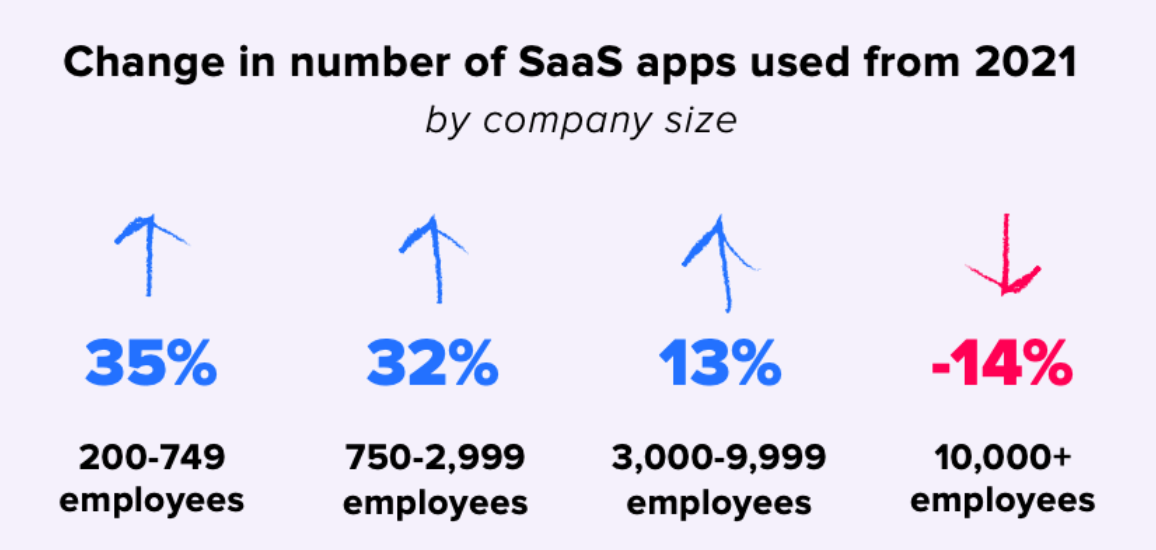SaaS statistics & trends to watch out for in 2023
Software as a Service (SaaS) has transformed the way businesses operate, offering users scalability and flexibility, liberated from the confines of traditional software.
2023 is just around the corner, which makes now the perfect time to get ahead of SaaS trends and start planning for what’s next.
With increasing exponential growth, it has become essential for IT professionals, executives and project managers across industries to stay up-to-date on the latest industry news, empowering them to make informed decisions about their SaaS strategy.
In this blog post, we're going to explore what 2022 looked like and what 2023 holds for SaaS by looking at some relevant statistics and trends that are taking shape.
SaaS Market Overview
SaaS will be worth approximately $195 billion in 2023. (Gartner)
This is forecast to be 16.8% more than in 2022 when the SaaS market was worth approximately $167 billion.
This goes to show that SaaS growth won’t be slowing down next year. SaaS offers a number of benefits over on-premise software. Many organisations worldwide are opting for SaaS-based solutions due to increased flexibility, ability to scale, easy updates and deployment.
SaaS accounts for 19% of companies' annual tech spend worldwide. (Flexera)
SaaS was the third biggest priority for companies in terms of IT spend. People and services accounted for 25%, while on-premises software for 20%.
However, the trend shows that companies increasingly turn to SaaS to cater for remote employees, while spending associated with on-premises software is expected to decrease.
There are more than 32,000 SaaS companies worldwide. (Latka)
The US has the largest proportion (approx. 51%) with around 17,000 SaaS companies. This is almost 15,000 more than the second largest market which is the United Kingdom with around 2,000.
Next in line are Canada (~2,000), Germany (~1,000), France (~1,000) and India (~1,000).
There were 373 SaaS startups founded in the last year. (Crunchbase)
We’re likely to see more and more SaaS companies emerging in 2023. Entrepreneurs strive to build a SaaS as it allows them to quickly scale with the right architecture and generate a passive income through monthly recurring revenue.
SaaS Usage
Organisations now use 130 SaaS apps on average. (BetterCloud)
In the last 7 years, organisations have gone from using just 8 SaaS products on average to a whopping 130 apps which marks 16x growth, with the biggest jump being from 2017 (16 apps) to 2020 (80 apps).
Large enterprises used the most SaaS products this year at 410, however, medium-sized companies adopted new apps at a faster rate than any other group.

SaaS Deployment
Today’s average deployment time of SaaS apps is 7 hours. (G2)
Compared to a decade ago when it took on average 54 hours to deploy SaaS, we can’t but reflect on how far technology has advanced.
This is in large part due to API integrations that allow new software to be quickly and seamlessly deployed. By leveraging pre-existing API calls, the manual steps that can delay application distribution are eliminated, reducing the time it takes from conception to completion.
Integrating APIs also ensures data accuracy since APIs offer a more reliable connection than custom webhooks or other methods. This process makes deploying and integrating SaaS applications with a company’s existing tech stack more efficient and cost effective in both the short and long term.
SaaS Challenges
Onboarding
It takes more than 1 day to get new employees access to the tools they need. (BetterCloud)
51% companies report it takes more than 1 day to get new employees access to the tools they need, while 35% said it takes more than a week. 86% overall say that new employees lack access to the necessary tools to do their jobs on day 1.
Spending
57% of IT teams are under pressure to reduce SaaS spend. (Workato)
This pressure on IT teams to reduce SaaS spend is being driven by the need to manage SaaS subscriptions as efficiently as possible. However, with the growing rate of SaaS adoption, this gets harder to achieve as complexity and cost increase.
To tackle that, some of the strategies organisations will be looking to implement include a vendor management system to better identify ways to cut costs as well as wind down redundant apps as new ones are being deployed.
Security
42% of companies report experiencing difficulties securing SaaS apps. (BetterCloud)
The leading concern for companies regarding their SaaS stack is security. Even though SaaS solutions are generally user-friendly and require minimal setup, they can still be vulnerable to external threats unless proper security protocols are in place. That’s why how to keep user activity and sensitive data secure is a rising priority for organisations.
51% had experienced a ransomware attack that targeted their SaaS data, and 52% of these attacks were successful. (Odaseva)
SaaS data is particularly vulnerable to ransomware attacks due to its centralised storage and easy access. Companies must be proactive - implementing security measures such as regular back-ups, multi-factor authentication, intrusion-prevention systems and a well-defined incident response plan.
79% report that recovering from a ransomware attack took days or longer. (Odaseva)
Recovering from a ransomware attack can be a daunting task. The most important thing is to have well-defined policies for backing up and archiving your data, as well as ensuring that all of your security measures are up-to-date.
43% agree that security misconfigurations lead to security incidents. (Adaptive Shield)
Security misconfigurations present an ongoing challenge for companies using SaaS products. Security weak spots should be identified and addressed on a timely basis before serious damage can occur. However, most companies monitor and update security settings manually which leaves room for malicious attacks.
1 in 4 organisations take one week or longer to resolve a misconfiguration, with 57% of companies using manual methods to check for security misconfigurations. (Adaptive Shield)
Manually resolving security misconfigurations can be a time-consuming process. It can take hours to track down the source of the misconfiguration and apply the necessary fixes. That’s why organisations are increasingly looking into automation to decrease the time it takes to find and resolve security faults in their SaaS stack.
The need for automation
86% of companies think automation is critical to addressing current SaaS challenges. (BetterCloud)
With an increasing number of companies deploying cloud-based solutions, it becomes increasingly difficult for IT teams to oversee the entire SaaS stack.
Automation will assist with onboarding new users, offboarding those who transfer or leave the company and managing the SaaS stack while ensuring security protocols are met.
This level of streamlined efficiency will become even more integral when management must manage increasingly complex customer needs and ever-shifting security regulations.
Increasing use of AI
It’s likely that we'll see more and more SaaS tools utilising artificial intelligence in 2023. By taking on the workload that bogged down teams before, AI will enable many SaaS apps to streamline their processes and provide better customer service.
From understanding customers' needs and automating everyday tasks, to creating a more personalised experience with predictive analytics - AI can help SaaS companies get a competitive edge.
The use of AI can also alleviate security concerns. AI-powered systems can be used to monitor the security status of SaaS apps, flag any suspicious activity and alert teams before any malicious behaviour takes place.
Wrapping up
While it seems that the exponential growth of SaaS might be finally slowing down a bit, it surely isn’t coming to a full stop anytime soon. And all signs point to 2023 being a big year for SaaS with some changes ahead.
With so many companies moving to the cloud and adopting new SaaS apps in their stack, it’s an exciting time to be in the industry. But it’s also extremely important to effectively manage SaaS environments and address any limitations.
Security concerns and increased efficiency will continue to be top of mind as companies look for ways to secure sensitive data, mitigate risks and reduce spend. We can expect to see an increase in automation and AI use cases as a solution to some of the most pressing challenges.
Now we turn it to you. What other trends do you see coming about in the SaaS space? We’d love to hear from you in the comments below!




